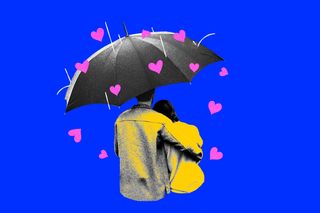
Why We Find Rains Romantic, According to Science
The familiarity and predictability of the sound of rain, alongside its sensory impact, reduces anxiety and puts us at ease.

From “Ek Ladki Bheegi Bhaagi Si” (1958) and “Rimjhim Gire Saawan” (1979) to “On the Roof, In the Rain” (2004) and “Cham Cham” (2016), Bollywood has long nurtured a sense of romanticism surrounding monsoons in the hearts of Indians — especially the ones privileged enough to not be inconvenienced by the season. But Bollywood has only bolstered these sentiments, not bred them. Standing under an umbrella — or, a blazer, à la Aashiqui 2 (2013) — with the person we love, isn’t all that we aspire to do in the monsoons.
Having chai and pakoras — while the cool monsoon winds gently dissolve the miserable memories of the summer heat and our olfactory senses dive into petrichor delight — has probably preceded Bollywood. In fact, it’s likely that filmmakers, too, capitalized on Indians’ enchantment with the monsoons. But what, indeed, is at the root of this allure of monsoons, and how has it been sustained across generations?
Historically — referring to actual history, not the fictionalized narrative we witnessed in “Ghanan Ghanan Nan” (2001) — since India is a tropical country, the monsoon has been hailed for bringing relief from the scorching summers and rejuvenating the parched earth.
But, per se, too, rain has the ability to steer us to relief. The sheer number of videos on YouTube featuring the sound of raindrops — deemed to be especially suited for relaxation and the beckoning of slumber — speaks to its soothing effect. “Like how music affects both the autonomic and limbic parts of our nervous system (that look after our heartbeat and emotions respectively), rainfall’s consistent, predictable sound can help regulate our nervous system’s responses,” explains Marianne Rizkallah, a music psychotherapist. “Our minds become accustomed to the rhythmic pitter-patter quickly. It’s not too loud and doesn’t come with any big aural surprises – both things we know our brains are sympathetic to.”
It’s the familiarity and predictability of the sound of rain that put our minds at ease immediately. When someone is trying to settle in a new city, for instance, everything from the roads to the people to the language they speak is different; but then come the monsoons, with the universal sound of the pitter-patter that makes us feel at home, enveloping us in a sense of nostalgia, familiarity, and freshness. Just like how the music we hear as children or even young adults can have a lasting impact on our memory — due to a psychological phenomenon called the reminiscence bump. — so can the sound of rain.
Related on The Swaddle:
Bollywood’s Soul Resided in Its Love Stories. Are They Disappearing?
Besides nostalgia-inducing familiarity, rain also evokes a sensory response that contributes to the euphoria of monsoons. Speaking to Stylist about how “the sound of raindrops taps into our senses,” liberating us, psychotherapist Katerina Georgiou states: “When we’re feeling anxious about life or even in a state of panic, we can feel caught up in our minds and heads, and it’s well understood that grounding techniques that place us in connection with our senses can take us out of our minds and back in connection with our bodies… The sound of raindrops helps us to do just this: the sound on the windowsill engages our hearing, while if we’re out in the rain, the physical sensation adds touch.”
Experts also note that the sound of raindrops tapping on the rooftops and window-sills is a form of pink noise, which is known to reduce brain activity and make sleep less elusive.
Research further suggests that the rain enhances our productivity by improving our concentration. This isn’t, however, a consequence of rains doing much, by itself, to make us focus better. Instead, it is about the weather not being conducive for much else that keeps people from being distracted by thoughts of outdoor activities. Nonetheless, since we live in an age where we associate our sense of self-worth with how productive we’ve been, being able to accomplish pending tasks while it showers outside, can lead us to associate the bliss of being happy with ourselves with rains.
Related on The Swaddle:
Why Bollywood’s Classic ‘Chiffon Sarees in Snow’ Trope Isn’t Cutting it Anymore
Further, the way rains cleanses one’s surroundings and breathe new life into to flora around us, brings hope for emotional cleansing and the prospect of fresh starts. This reinforces the perception of rain as a metaphor for release and renewal, offering opportunities for emotional catharsis and rekindling affectionate bonds.
Additionally, in the Indian context, since rains sustain crops, replenish water resources, and foster prosperity, monsoons are hailed as a source of abundance and prosperity — subtly intertwining with its romantic associations and deepening our emotional bond with rains.
Evidently, the romance that rains bring is, at its core, an intricate tapestry woven from various threads of influence — psychological, social, and cultural. So, perhaps, it wasn’t just actor Raveena Tandon’s wet saree and gyrating hips — coupled with singers Alka Yagnik and Udit Narayan’s mesmerizing voices — that made “Tip Tip Barsa Paani” (1994) such a hit; the audiences were already wired to love it.
It’s also pertinent to remember, though, that not everyone’s experience of the rain is bound to be alike — our socio-economic privileges, cities of residence, and even our genders can dictate the way rains make us feel. As someone anonymously wrote: “‘Romanticizing rain is the prerogative of the privileged’ — thought he, standing knee-deep in the rainwater.”
Devrupa Rakshit is an Associate Editor at The Swaddle. She is a lawyer by education, a poet by accident, a painter by shaukh, and autistic by birth. You can find her on Instagram @devruparakshit.
Related


Is Delaying, Suppressing Periods Worth the Risk?
